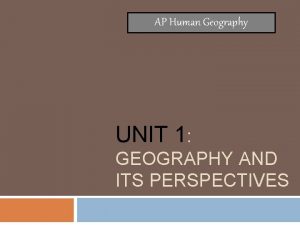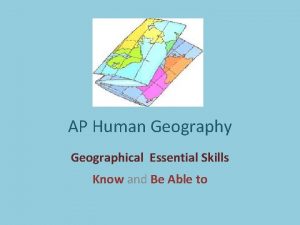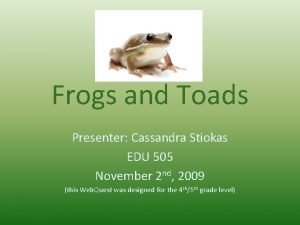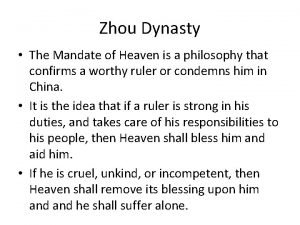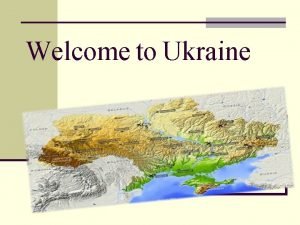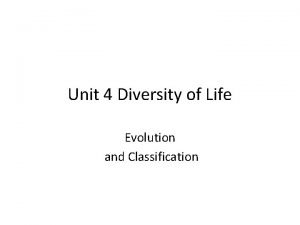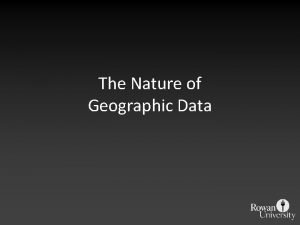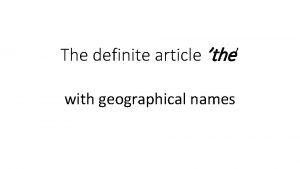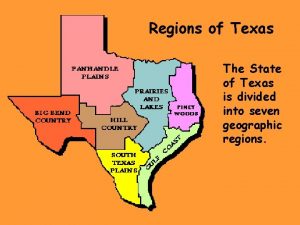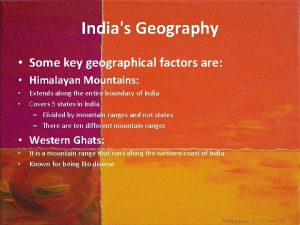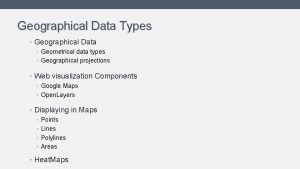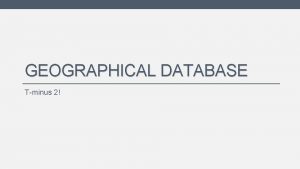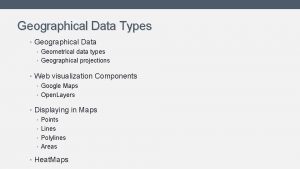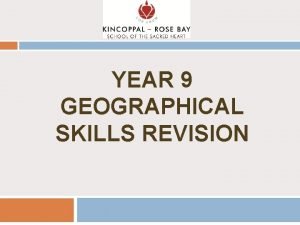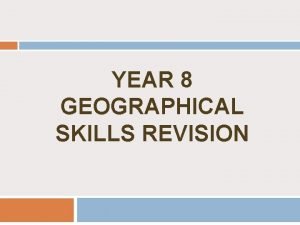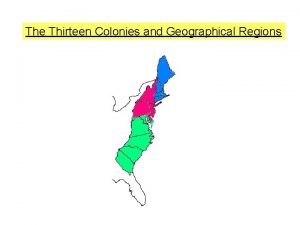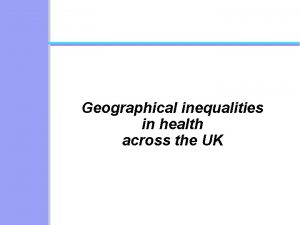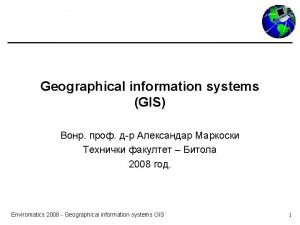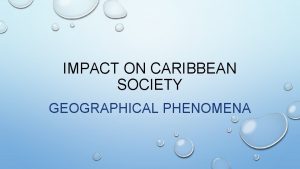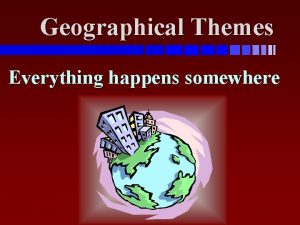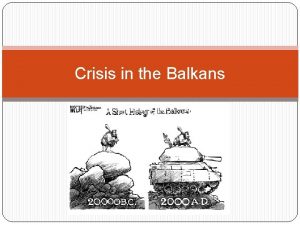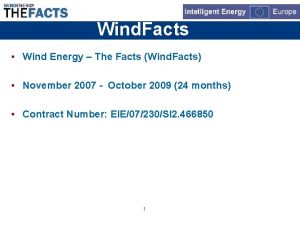GEOGRAPHICAL FACTS What is Geography Here are some






























- Slides: 30

GEOGRAPHICAL FACTS What is Geography? Here are some cool geographical facts.

Alaska • More than half of the coastline of the entire United States is in Alaska.

Amazon • The Amazon rainforest produces more than 20% the world's oxygen supply. • The Amazon River pushes so much water into the Atlantic Ocean that, more than one hundred miles at sea off the mouth of the river, one can dip fresh water out of the ocean. The volume of water in the Amazon river is greater than the next eight largest rivers in the world combined and three times the flow of all rivers in the United States.

Antarctica • • Antarctica is the only land on our planet that is not owned by any country. Ninety percent of the world's ice covers Antarctica. This ice also represents seventy percent of all the fresh water in the world. As strange as it sounds, however, Antarctica is essentially a desert. The average yearly total precipitation is about two inches Although covered with ice (all but 0. 4% of it, ice. ), Antarctica is the driest place on the planet, with an absolute humidity lower than the Gobi desert.

Brazil • Brazil got its name from the nut, not the other way around.

Canada • Canada has more lakes than the rest of the world combined. Canada is an Indian word meaning ' Big Village. '

Chicago • Next to Warsaw , Chicago has the largest Polish population in the world.

Detroit • Woodward Avenue in Detroit, Michigan, carries the designation M-1, so named because it was the first paved road anywhere.

Damascus, Syria • Damascus, Syria, was flourishing a couple of thousand years before Rome was founded in 753 BC, making it the oldest continuously inhabited city in existence.

Istanbul, Turkey • Istanbul, Turkey, is the only city in the world located on two continents.

Los Angeles • Los Angeles's full name is El Pueblo de Nuestra Senora la Reina de Los Angeles de Porciuncula and can be abbreviated to 3. 63% of its size: L. A.

New York City • The term 'The Big Apple' was coined by touring jazz musicians of the 1930's who used the slang expression 'apple' for any town or city. Therefore, to play New York City is to play the big time - The Big Apple. • There are more Irish in New York City than in Dublin , Ireland ; more Italians in New York City than in Rome, Italy ; and more Jews in New York City than in Tel Aviv, Israel.

Ohio • There are no natural lakes in the state of Ohio; all are manmade.

Pitcairn Island • The smallest island with country status is Pitcairn in Polynesia, at just 1. 75 sq. miles/4, 53 sq. km. It was founded by the mutineers of The Bounty.

Rome • The first city to reach a population of 1 million people was Rome , Italy in 133 B. C. There is a city called Rome on every continent.

Siberia • Siberia contains more than 25% of the world's forests.

S. M. O. M. • The actual smallest sovereign entity in the world is the Sovereign Military Order of Malta (S. M. O. M). It is located in the city of Rome, Italy, has an area of two tennis courts, and as of 2001 has a population of 80, 20 less people than the Vatican. It is a sovereign entity under international law, just as the Vatican is.

Sahara Desert • In the Sahara Desert , there is a town named Tidikelt , Algeria , which did not receive a drop of rain for ten years.

Antarctic Desert • Technically though, the driest place on Earth is in the valleys of the Antarctic near Ross Island. There has been no rainfall there for two million years.

Spain • Spain literally means 'the land of rabbits. '

St. Paul Minnesota • St. Paul, Minnesota , was originally called Pig's Eye after a man named Pierre 'Pig's Eye' Parrant who set up the first business there.

Roads • Chances that a road is unpaved in the U. S. A : 1%, in Canada : 75%

Russia’s Big Dig • The deepest hole ever drilled by man is the Kola Superdeep Borehole, in Russia. It reached a depth of 12, 261 meters (about 40, 226 feet or 7. 62 miles). It was drilled for scientific research and gave up some unexpected discoveries, one of which was a huge deposit of hydrogen - so massive that the mud coming from the hole was boiling with it.

United States • The Eisenhower interstate system requires that onemile in every five must be straight. These straight sections are usable as airstrips in times of war or other emergencies.

Venezuela • The water of Angel Falls (the World's highest) in Venezuela drops 3, 212 feet (979 meters). They are 15 times higher than Niagara Falls.

So, that is some of what geography is… • I have always said , you should learn something new every day. • Enjoy your Day! • Now let’s define some terms.

Today’s Notes • Start a new Page in Notebook • On top Line- Today’s date and What is Geography? • Begin Notes– Nothing else on this page after notes.

Geography is: • Literally, geography means to study and write about the Earth and its inhabitants. • Geography has 2 main subdivisions— – Physical Geography is the study of the Earth and all its flora (plants), fauna (wildlife), environments, land water forms. (Physical Science) – Human or Cultural Geography is the study of the inhabitants of the Earth and how they interact with the Earth. (Social Science)

Geography has: • 5 Themes that you covered last year. – Location- tells where something is • Absolute- longitude and latitude • Relative- location in relation to another (familiar) location. Ex: “The athletic fields are around the corner from the school. ” – Place- describes a location • Physical Characteristics- What does it look like? • Human Characteristics- How have humans interacted with the location? (population, activities, culture, etc. )

Geography has: • Human Environment Interaction- How has the environment affected people, and how do people affect their environment? • Movement- How do people, things and ideas move and spread throughout the world? • Region- How do Geographers group locations by unifying characteristics? (extension of place)
 Insidan region jh
Insidan region jh Spatial ap human geography
Spatial ap human geography Geographical data ap human geography definition
Geographical data ap human geography definition There's a place where mercy reigns and never dies
There's a place where mercy reigns and never dies Here follow some verses
Here follow some verses Here are some tips
Here are some tips Put some order here
Put some order here Here are the tips
Here are the tips They say sometimes you win some
They say sometimes you win some God when you choose to leave mountains unmovable
God when you choose to leave mountains unmovable Pear countable or uncountable
Pear countable or uncountable What is contact force
What is contact force Fire and ice diamante poem
Fire and ice diamante poem Some say the world will end in fire some say in ice
Some say the world will end in fire some say in ice Some may trust in horses
Some may trust in horses What are some fun facts about ruby bridges
What are some fun facts about ruby bridges Fun facts about helium
Fun facts about helium What are some interesting facts about dolphins
What are some interesting facts about dolphins What are some interesting facts
What are some interesting facts Cassandra make a venn diagram
Cassandra make a venn diagram Fall of the zhou dynasty
Fall of the zhou dynasty What are some interesting facts about ladybugs
What are some interesting facts about ladybugs Ukraine geographical position
Ukraine geographical position Can different species reproduce
Can different species reproduce Registration process of geographical indication
Registration process of geographical indication Registration of geographical indication
Registration of geographical indication Southeast region agriculture
Southeast region agriculture Nature of geographic data
Nature of geographic data The with geographical names
The with geographical names Roman architecture
Roman architecture The seven regions of texas
The seven regions of texas

